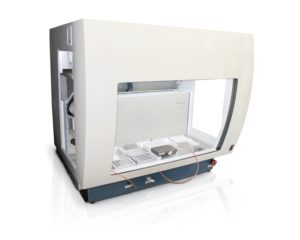On June 26th, 2022, United Nations Office on Drugs and Crime (UNODC) released the 2022 World Drug Report claiming that about 284,000,000 people worldwide aged 15–64 had used a drug within the last 12 months in 2020, increased by 26% over the previous decade.
Why automate drug testing?
As drug use increases, the demand for drug testing also increases. Hence, it is necessary to develop a high-throughput method capable of simultaneously analyzing the major drugs of abuse and their metabolites in urine specimens. The time-consuming step of the testing process is sample preparation which generally uses solid-phase extraction (SPE). SPE is a sample extraction technique by which dissolved or suspended compounds in a liquid mixture are separated according to their physical and chemical properties. It enables the extraction, cleanup, and concentration of analytes preceding their quantification. Manual workflow of SPE can be time-consuming and prone to human errors.
Workflow of SPE for drug testing
In SPE, the target analyte is separated from the undesirable components due to the difference of affinity between analytes and interferents in a liquid mixture.
Typically, SPE involves four steps:
- Conditioning
- Loading
- Washing
- Elution.
Conditioning
To wet the sorbent, the column is conditioned with a solvent.
Conditioning of the adsorbent is necessary to ensure reproducible interaction with the analyte.
It wets adsorbent and thus produces an environment suitable for adsorption of the analyte.
Loading
The solution containing the analyte is loaded, and the analyte and some impurities are retained on the sorbent.
Washing
The sorbent is washed with a special wash solution to remove any impurities that may be weakly bound compared to the strongly bound analyte.
Elution
During the elution step, the analyte is collected.
This step is designed to selectively recover the analyte by disrupting the analyte-sorbent interaction.
Advantages of automating solid phase extraction
However, automation of SPE not only increases the throughput and efficiency but also reduces cross-contamination and human error. Aurora VERSA automated Solid Phase Extraction systems (aka automated SPE systems) fully automate SPE workflows from cartridge conditioning to sample derivatization. With the combination of the ReagentDrop™ dispenser, Heater-Shaker, Gripper, and Nitrogen Dryer, VERSA automated solid phase extraction (SPE) systems act to produce contamination-free sample pre-processing and trace analyte enrichment before performing sample analysis by a chromatography-based platform (HPLC, GCMS, HPLC-MS, etc).
The ReagentDrop™ dispenser reduces waste by dispensing liquids out of a bottle instead of using plastic tips to transfer between two containers. The temperature range of the heater-shaker is room temperature to 90 ° C. The gripper on the VERSA lab robot moves plates.
For drug testing cross-contamination and human errors are important issues. Getting the wrong result can lead to lawsuits. Reduce these challenges in drug testing with automation.
Real world example
Dr. Thiangthum and Dr. Tanunkat from Bureau of Drug and Narcotic of Thailand use the VERSA 1100 automated Solid Phase Extraction system to quantify amphetamine and methamphetamine in drug users’ urine samples. They test more than 100,000 urine samples with VERSA automated SPE workstation each year.
Solid phase extraction can now be automated for drug testing, including urine samples. If you are interested in automating drug testing contact us. Our solutions can be customized around your needs.






